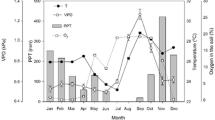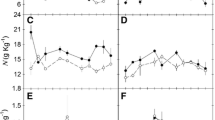Summary
Demography and physiology of two broad-leaved understory tropical herbs (Marantaceae) were studied in gaps and shaded understory in large-scale irrigated and control treatments during the dry season at Barro Colorado Island (BCI), Panama. Because photosynthetic acclimation potential may not predict light environments where tropical species are found, we studied a suite of physiological features to determine if they uniquely reflect the distribution of each species. Calathea inocephala and Pleiostachya pruinosa grow and reproduce in gaps, persist in shade, and have equivalent rates of leaf production. Calathea leaves survived 2 to 3 times as long as leaves of Pleiostachya and plants of Pleiostachya were 6 to 8 times more likely to die as plants of Calathea during 3.5 years of study. Pleiostachya had lowest survival in shade and when not irrigated during the dry season, while Calathea survived well in both habitats and both treatments. Pleiostachya had higher photosynthetic capacity and stomatal conductance than Calathea and acclimated to gaps by producing leaves with higher photosynthetic capacity. Calathea had lower mesophyll CO2 concentrations than Pleiostachya. Both species had similar dark respiration rates and light compensation points, and water-use and nitrogen-use efficiencies were inversely related between species. Species showed no differences in leaf osmotic potentials at full turgor. Calathea roots were deeper and had tuberous swellings.
Leaf-level assimilation and potential water loss are consistent with where these species are found, but photosynthetic acclimation to high light does not reflect both species' abilities to grow and reproduce in gaps. Pleiostachya's gap-dependent, rapid growth and reproduction require high rates of carbon gain in short-lived leaves, which can amortize their cost quickly. High rates of water loss are associated with reduced longevity during drought. Calathea's roots may confer greater capacitance, while its leaves are durable, long-lived and have lower water loss, permitting persistence long after gap closure.
Similar content being viewed by others
References
Augspurger CK (1984) Seedling survival of tropical tree species: interactions of dispersal distance, light gaps and pathogens. Ecology 65:1705–1712
Bazzaz FA, Pickett STA (1980) Physiological ecology of tropical succession: a comparative review. Ann Rev Ecol Syst 11:287–310
Becker P, Rabenold PE, Idol JR, Smith AP (1988) Gap and slope gradients of soil and plant water potentials during the dry season in a tropical moist forest. J Trop Ecol 4:173–184
Boardman NK (1977) Comparative photosynthesis of sun and shade plants. Ann Rev Plant Physiol 28:355–377
Boot GAR, den Dubbelden KC (1990) Effects of nitrogen supply on growth, allocation and gas exchange characteristics of two perennial grasses from inland dunes. Oecologia 85:115–121
Boyer JS (1969) Measurement of the water status of plants. Ann Rev Plant Physiol 16:473–516
Brokaw NVL (1982) Gap phase regeneration in a Neotropical forest. Dissertation. University of Chicago. Chicago IL. 175 pp
Caemmerer S von, Farquhar GD (1981) Some relationships between the biochemistry of photosynthesis and the gas exchange of leaves. Planta 153:376–387
Caemmerer S von, Farquhar GD (1984) Effects of partial defoliation, changes of irradiance during growth, short-term water stress and growth at enhanced p(CO2) on the photosynthetic capacity of leaves of Phaseolus vulgaris L. Planta 160:320–329
Chabot BF, Hicks DJ (1982) The ecology of leaf life spans. Ann Rev Ecol Syst 13:229–259
Chazdon RL (1986) The costs of leaf support in understory palms: economy versus safety. Am Nat 127:9–30
Chazdon RL, Field CB (1987) Determinants of photosynthetic capacity in six rainforest Piper species. Oecologia 73:222–230
Chiariello NR, Field CB, Mooney HA (1987) Midday wilting in a tropical pioneer tree. Funct Ecol 1:3–11
Croat TB (1978) Flora of Barro Colorado Island. Stanford University Press, Stanford, 943 pp
Evans, JR (1989) Photosynthesis and nitrogen relationships in leaves of C3 plants. Oecologia 78:9–19
Farquhar GD, von Caemmerer S (1982) Modelling of photosynthetic response to environmental conditions. Encycl Plant Physiol NS 12B:549–588
Feder M (1987) (ed) New directions in ecological physiology. Cambridge Univ Pr, Cambridge. 364 pp
Fetcher N, Strain BR, Oberbauer SF (1983) Effects of light regime on growth, leaf morphology, and water relations of seedling of two species of tropical tree. Oecologia 58:314–319
Fetcher N, Oberbauer SF, Rojas G, Strain BR (1987) Efectos del regimen de luz sobre la fotosintesis y el crecimiento en plantulas de arboles de un bosque lluvioso tropical de Costa Rica. Rev Biol Trop 35 (Suppl 1):97–110
Field C (1983) Allocating leaf nitrogen for the maximization of carbon gain: leaf age as a control on the allocation program. Oecologia 56:341–347
Field C (1983) The role of photosynthetic responses in constraining the habitat distribution of rainforest plants. Aust J Plant Physiol 15:343–358
Field C, Mooney HA (1986) The photosynthesis-nitrogen relationship in wild plants. In: Givnish TJ (ed) On the economy of plant form and function. Cambridge University Press Cambridge, pp 25–50
Field C, Merino J, Mooney HA (1983) Compromises between water-use efficiency and nitrogen-use efficiency in five species of California evergreens. Oecologia 60:384–389
Gurevitch J, Chester ST (1986) Analysis of repeated measures experiments. Ecology 67:251–254
Gulmon SL, Mooney HA (1986) Costs of defense and their effects on plant productivity. In: Givnish TJ (ed) On the economy of plant form and function. Cambridge University Press, Cambridge, pp 681–698
Harper JL, Ogden J (1970) The reproductive strategy of higher plants. 1. The concept of strategy with special reference to Senecio vulgaris L. J Ecol 58:681–698
Horvitz CC (In press) Light environments, stage-structure and dispersal syndromes of Costa Rican Marantaceae: a preliminary survey of ant- and bird-dispersed species. In: Oxford symposium on interactions between ants and plants. Oxford Univ Press, Oxford, UK
Janzen DH (1970) Herbivores and the number of tree species in tropical forests. Am Natur 104:501–528
Kirschbaum MUF, Farquhar GD (1984) Temperature dependence of whole-leaf photosynthesis in Eucalyptus pauciflora Sieb. et Spreng. Aust J Plant Physiol 11:519–538
Kirschbaum MUF, Farquhar GD (1987) Investigation of the CO2 dependence of quantum yield and respiration in Eucalyptus pauciflora. Plant Physiol 83:1032–1036
Kitajima K, Augspurger CK (1987) Comparison of photosynthesis and shade tolerance of seedlings of Neotropical tree species. Bull Ecol Soc Am 68:340–341
Kitajima K, Augspurger CK (1989) Seed and seedling ecology of a monocarpic tropical tree Tachigalia versicolor. Ecology 70:1102–1114
Leigh EG, Rand AS, Windsor DM (1982) Ecology of a tropical forest: seasonal rhythms and long-term changes. Smithsonian Institution Press, Washington DC
Medina E, Oliveras E, Diaz M (1986) Water stress and light intensity effects on growth and nocturnal acid accumulation in a terrestrial CAM bromeliad (Bromelia humilis Jacq.) under natural conditions. Oecologia 70:441–446
Mooney HA, Chiariello NR (1984) The study of plant function — the plant as a balanced system. In: Dirzo R, Sarukhán J (eds) Perspectives on plant population ecology. Sinauer, Sunderland, MA pp 305–323
Mulkey SS (1986) Photosynthetic acclimation and water-use efficiency of three species of understory herbaceous bamboo (Gramineae) in Panama. Oecologia 70:514–519
Mulkey SS, Wright SJ, Smith AP (1991) Drought acclimation of an understory shrub in a seasonally dry tropical forest. Am J Bot 78:579–587
Nobel PS (1980) Leaf anatomy and water use efficiency. In Turner NC, Kramer PJ (eds) Adaptation of plants to water and high temperature stress. Wiley, NY pp 43–55
Oberbauer SF, Strain BR, Riechers GH (1987) Field water relations of a wet tropical forest tree species, Pentaclethra macroloba (Mimosaceae). Oecologia 71:369–374
Page AL (1982) Methods of soil analysis part II, chemical and microbiological properties. Agronomy 9. Am Soc Agron Inc 1159 pp
Pearcy RW, Calkin H (1983) Carbon dioxide exchange of C3 and C4 tree species in the understory of a Hawaiian forest. Oecologia 58:26–32
Richards PW (1952) The tropical rain forest. Cambridge University Press, London.
Robichaux RH, Rundel PW, Stemmermann L, Canfield J, Morse SR, Friedman E (1984) Tissue water deficits and plant growth in wet tropical environments. In: Medina E, Mooney HA, Vazquez-Yanes C (eds), Physiological ecology of plants of the wet tropics. Dr. W. Junk, The Hague, pp. 129–138
Sage R, Pearcy RW (1987) The nitrogen use efficiency of C3 and C4 plants II. Leaf nitrogen effects on the gas exchange characteristics of Chenopodium album (L.) and Amaranthus retroflexus (L.). Plant Physiol 84:959–963
Schreiber U, Neubauer C, Klughammer C (1989) Devices and methods for room temperature fluorescence analysis. Phil Trans Roy Soc Lond B 323:241–251
Schulze E-D (1986) Carbon dioxide and water vapor exchange in response to drought in the atmosphere and the soil. Annu. Rev. Plant Physiol 37:247–274
Sharkey TD (1985) Photosynthesis in intact leaves of C3 plants: physics, physiology, and rate limitations. Bot Rev 51:54–104
Sharkey TD, Seemann JR (1989) Mild water stress effects on carbon-reduction-cycle intermediates, ribulose biosphospate carboxylase activity, and spatial homogeneity of photosynthesis of intact leaves. Plant Physiol 89:1060–1065
Sharkey TD, Vassey TL (1989) Low oxygen inhibition of photosynthesis is caused by inhibition of starch synthesis. Plant Physiol 90:385–387
Sims DA, Pearcy RW (1989) Photosynthetic characteristics of a tropical forest understory herb, Alocasia macrorrhiza and a related crop species, Colocasia esculenta grown in contrasting light environments. Oecologia 79:53–59
Smith AP (1987) Repuestas de hierbas del sotobosque tropical a claros ocasionados por la caida de arboles. Rev Biol Trop 35 (Suppl 1):111–118
Sokal RR, Rohlf JF (1981) Biometry. Freeman. San Francisco CA
Stitt M (1986) Limitation of photosynthesis by carbon metabolism. I. Evidence for excess electron transport capacity in leaves carrying out photosynthesis in saturating light and CO2. Plant Physiol 81:1115–1122
Turner NC, Jones MM (1980) Turgor maintenance by osmotic adjustment: a review and evaluation. In: Turner NC, Kramer PJ (eds) Adaptation of plants to water and high temperature stress, 87–103, Wiley, NY
Walters MB, Field CB (1987) Photosynthetic light acclimation in two rain forest Piper species with different ecological amplitudes. Oecologia 72:449–456
Windsor DM Climate and moisture availability in a tropical forest: long term records for Barro Colorado Island, Panama. Smith Contrib Ear Sci (in press)
Wright SJ, Cornejo FH (1990) Seasonal drought and leaf fall in a tropical forest. Ecology 71:1165–1175
Author information
Authors and Affiliations
Rights and permissions
About this article
Cite this article
Mulkey, S.S., Smith, A.P. & Wright, S.J. Comparative life history and physiology of two understory Neotropical herbs. Oecologia 88, 263–273 (1991). https://doi.org/10.1007/BF00320821
Received:
Accepted:
Issue Date:
DOI: https://doi.org/10.1007/BF00320821




